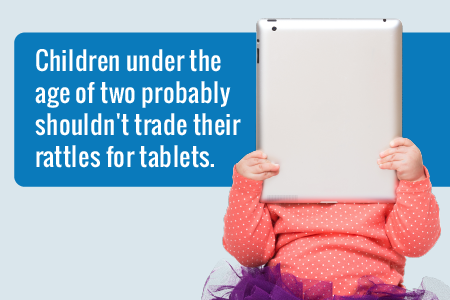If you’re a parent with a smartphone or tablet, you’ve no doubt experienced that moment when your little one first extends his or her tiny hands toward your shiny piece of technology. In fact, if their fingers weren’t covered in baby food at the time, you may have handed over the device to see how they’d react; forewarning, you will wipe away fingerprint smudges from your smartphone for years!
To your surprise—and theirs—it probably didn’t take long before they realized their curious swipes and taps made objects move on the screen. These moments can be entertaining, enlightening, and even emotional, but they also represent an important milestone that should be taken seriously. It’s perfectly acceptable, even beneficial, for young children to have these interactions, but parental involvement is key.
With proper parental guidance, children can strengthen their interactions with other family members, as well improve their familiarity with sounds, words, language, and knowledge through responsible use of technology. Most experts agree, however, that children under the age of two probably shouldn’t trade their rattles for tablets. There are enough real-world interactions to keep them busy,and whether they play with blocks or pull the cat’s tail, these tangible experiences are important to their development. There will be plenty of time to show them Angry Birds when they’re a bit older, so allow them to develop their senses by exploring, touching things and even getting into a little trouble.
Once beyond the 24-month mark, however, you may want to begin taking baby steps toward introducing technology to your tykes. Even if you haven’t let your child smear your smartphone screen at home, they may already enjoy the privilege at preschool; many toddler day-cares and preschools now incorporate technology, from computers to tablets, into their curriculum.
By using the technology with your children, you’ll introduce them to the most beneficial content, while also bonding with them over an exciting, shared experience. Something as simple and fun as taking turns in a game or reading together on a tablet can bring family members closer, and help ensure technology is being consumed in a responsible way that can educate and aid development.
While education is key, it doesn’t always have to be about learning your ABCs and 123s. Plenty of games, apps and TV shows combine learning and entertainment, delivering “edutainment”experiences that are fun for kids, while also meeting parental standards. Checking the rating and reading the app and game descriptions on digital storefronts is a great way to find appropriate content for kids of all ages.
As your little ones mature from toddlers to tweens, technology will evolve as well. The content they enjoy and most benefit from will also change, probably affecting how you manage and monitor their time with the tech. Regardless of where our smartphones and tablets take us and our kids, parental involvement and engagement is key to ensuring kids enjoy a healthy, responsible relationship with technology.


